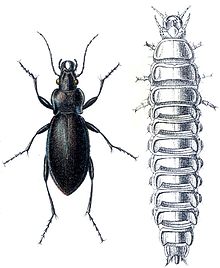Gold bar
| Gold bar | ||||||||||||
|---|---|---|---|---|---|---|---|---|---|---|---|---|

Gold bar ( Carabus violaceus ) |
||||||||||||
| Systematics | ||||||||||||
|
||||||||||||
| Scientific name | ||||||||||||
| Carabus violaceus | ||||||||||||
| Linnaeus , 1758 |
The gold bar , the violet ground beetle or violet-edged ground beetle ( Carabus violaceus ) is a beetle from the family of ground beetles (Carabidae).
features
The beetles reach a body length of 22 to 35 millimeters and have a very variable color and surface structure. They are colored black, on the edges of the pronotum and the wing ( elytra ) a red-violet, blue or blue-green border is usually recognizable. The finely wrinkled pronotum is mostly colored in one of these colors over a large area. The cover wings are elongated, oval and finely grained. Some specimens have fine ribs on them, which are separated by rows of dots. The antennae and legs are black. The penultimate limb of the labial palm has more than two bristles, the similar smooth ground beetle ( C. glabratus ) only has two such bristles.
Occurrence
The beetles are found almost everywhere in Europe and north of the Arctic Circle . They are also common in Asia to Eastern Siberia and Japan. In the southwest their distribution extends to the Pyrenees . The species has a strong tendency to form subspecies . The individual geographically separated subspecies were isolated in the Ice Age and have developed separately since then. They cross at their distribution limits (e.g. on the Rhine ). The two most important groups in Central Europe are the eastern violaceus group with its compact shape and unstriped elytra and the purpurascens group, which is the western subspecies. Their bodies are narrower and more elongated, the elytra are slightly striped. The beetles live in sparse forests , on meadows and on the coast, they are occasionally also found in near-natural house gardens. The adults live from June to August.
Way of life
The gold bar, like its larvae , is crepuscular and hunts on the forest floor. They prey on juvenile amphibians such as z. B. juvenile fire salamanders as well as snails, insects and spiders. But they also eat fresh carrion and mushrooms. The beetles like to hide under moss and stones. After three moults, the larva pupates in a burrow. The doll has developed a special protection against moisture in the ground . There are longer stiff bristles on her back that prevent the doll from coming into direct contact with the ground. Hibernation takes place both in the larval stage and as an imago.
literature
- KW Harde and F. Severa: The Kosmos Käferführer . Franckh-Kosmos Verlag, Stuttgart 2000, ISBN 3-440-06959-1 .
- Ekkehard Wachmann , Ralph Platen, Dieter Barndt: Ground beetles - observation, way of life , Naturbuch-Verlag Augsburg, 1995, ISBN 3-89440-125-7
- Jiři Zahradnik, Irmgard Jung, Dieter Jung, Jarmila Hoberlandtova, Ivan Zpevak: Beetles of Central and Northwestern Europe , Parey Berlin 1985, ISBN 3-490-27118-1
- Michael Chinery: Parey's Book of Insects: A Field Guide to European Insects. Translated and edited by Dr. Irmgard Jung and Dieter Jung. Paul Parey Publishing 1987. Hamburg and Berlin. ISBN 3-490-14118-0


